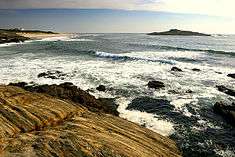Fort of Pessegueiro Island
| Fort of Pessegueiro Island (Forte da Ilha do Pessegueiro) | |
| Fort (Forte) | |
 The Fort of Pessegueiro Island across the 300 metre channel from the Fort of Pessegueiro Beach | |
| Official name: Forte na Ilha do Pessegueiro | |
| Name origin: Pessegueiro Island | |
| Country | |
|---|---|
| Region | Alentejo |
| Subregion | Alentejo Litoral |
| District | Setúbal |
| Municipality | Sines |
| Location | Porto Covo |
| - elevation | 21 m (69 ft) |
| - coordinates | PT 37°50′0.57″N 8°47′51.22″W / 37.8334917°N 8.7975611°WCoordinates: PT 37°50′0.57″N 8°47′51.22″W / 37.8334917°N 8.7975611°W |
| Length | 31.15 m (102 ft), North-South |
| Width | 19.02 m (62 ft), West-East |
| Architects | Filipe Terzi, Alexandre Massay |
| Materials | Ashlar Masonry, Stone |
| Origin | c. 1588 |
| - Initiated | c. 1590 |
| - Completion | c. 1690 |
| Owner | Portuguese Republic |
| For public | Public |
| Easiest access | Island of Pessegueiro, via Porto Covo |
| Management | Instituto Gestão do Patrimonio Arquitectónico e Arqueológico |
| Status | Property of Public Interest Imóvel de Interesse Público |
| Listing | Decree 41/191; Diário do Governo, 162 (18 June 1957) |
| Wikimedia Commons: Forte da Ilha do Pessegueiro | |
The Fort of Pessegueiro Island (Portuguese: Forte da ilha do Pessegueiro) is a fort situated on the island of Pessegueiro, off the coast of the civil parish of Porto Covo, municipality of Sines, in the southern Alentejo of Portugal.
History
.jpg)
There are still visible on the island of Pessegueiro enormous blocks cut from the rocks of the island, and sunk in the waters around it.[1] Similarly, there have been discovered various tanks for salting fish, that were used during the early Roman occupation of the region. These tanks were used in the salting and processing of fish, which was traded and transported to Rome.[1]
In 1588, Terzi began the planning for a fort on the island, as part of a project to construct an artificial port that would link the island to the coast (then approved by cardinal Alberto, the vice-King).[1][2] Alexandre Massay substituted Terzi in 1590, beginning the construction of the port, while work on the artificial port continued.[1][2] The construction was interrupted in 1598, when Massay was transferred to Vila Nova de Milfontes, to begin work on the construction of a fort to defend the inlet to the River Mira.[1][2]
Construction began once again in 1603, but were interrupted shortly later.[1][2] It is unclear, but construction on the island was likely completed between 1661 and 1690, although the fort and artificial port remained incomplete.[1]
The 1755 Lisbon earthquake was responsible for damage to the chapel, and the batteries over the casemates.[1]
Architecture
The Fort of Pessegueiro Island dominates the beach and coast of Pessegueiro, an area of southern Porto Covo. The island and fort are located opposite another fort, referred to as the Fort of Pessegueiro.
Of the fort that remains on the island, the existing structure exists in ruins.[1] It is a star-shaped fort, consisting of four symmetrical, triangular bulwarks and with casemates in the central part of the fortification. On the opposite end of the main entrance is a hermitage, dedicated to Santo Alberto (Portuguese: Ermida de Santo Alberto).[1]
The fort was part of group that included an artificial port, defended by a breakwater also connected the island to the rocky outcroppings to the north of the island: the Penedo do Cavalo.[1]
References
- Notes
- 1 2 3 4 5 6 7 8 9 10 11 Mendonça, Isabel; Matias, Cecília (2011). SIPA, ed. "Forte na Ilha do Pessegueiro" (in Portuguese). Lisbon, Portugal: SIPA – Sistema de Informação para o Património Arquitectónico. Retrieved 14 January 2012.
- 1 2 3 4 IGESPAR, ed. (2011). "Forte do Pessegueiro, incluindo a ilha do mesmo nome, abrangendo o Forte da Ilha de Dentro" (in Portuguese). Lisbon, Portugal: IGESPAR-Instituto de Gestão do Património Arquitectónico e Arqueológico. Retrieved 16 January 2012.
- Sources
- Callixto, Carlos (3 October 1981), O Forte de Porto Covo (in Portuguese), O Dia
- Callixto, Carlos (21 September 1984), O Forte de Porto Covo (in Portuguese), Diário de Notícias
- Falcão, José António (1987), Memória paroquial do Concelho de Sines (in Portuguese), Santiago do Cacém, Portugal
- Mendes, João (5 May 1990), Pessegueiro em perigo (in Portuguese), Sábado
- Soledade, Arnaldo (1990), Sines: terra de Vasco da Gama, Sines
- Callixto, Carlos (23 February 1991), O Forte de Porto Covo (in Portuguese), Diário de Notícias